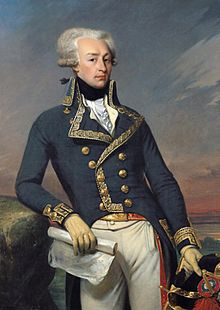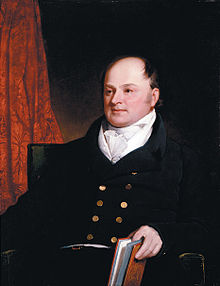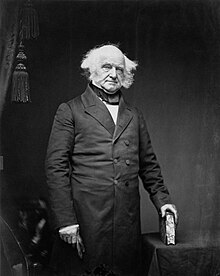Sidney Breese
During this time, Sidney befriended his distant (and slightly elder) cousin Elias Kent Kane, also a member of the Schuyler family of New York.
Secretary of State until the end of the legislative session in 1821, when he returned to Kaskaskia and began a private law practice.
[11] By chance in 1821, he was approached in his law office one day by the Post-Office Department to assume the duties of Postmaster for Kaskaskia.
[12] Having removed to private practice following his dismissal in 1829, in 1831 Breese also began compiling the reports of the Illinois Supreme Court.
Following the outbreak of the Black Hawk War in 1832, Breese volunteered for military service, enlisting as a private.
After arriving at Camp Wilborn, the Lieutenant-Colonel Theophilus W. Smith (a Judge on the Illinois Supreme Court) resigned, and Breese was elected to fill the open position.
[13] Breese also platted an addition to the new town of Chicago, and helped early settler and trader Jean Baptiste Beaubien with his land claim which included the soon-decommissioned Fort Dearborn, which succeeded with the Illinois Supreme Court but was reversed by the United States Supreme Court, despite the efforts of appellate counsel Francis Scott Key and Daniel Webster in Wilcox v. Jackson (1837).
[13] A case filed in his court in 1838 concerned whether the Governor (then Whig Joseph Duncan) could remove a Secretary of State (Democrat Alexander Pope Field) and appoint another.
[citation needed] In a heated partisan atmosphere, Breese delivered a purely legal opinion which upheld the Governor's power.
In 1841, following the contested legal dispute, Breese assumed the duties as a Justice in the Illinois Supreme Court on February 22.
During his term he was considered a poor politician by insiders because he devoted his time and energy to the official duties of his office and people of Illinois versus the financiers and special interests of the Democratic Party and Washington establishment.
[17] However, bittersweetly, a project he had long advocated and pushed for while in Washington, the Illinois Central Railroad, was approved as he left office.
Starting in 1835, Breese began lobbying for a railroad connecting the Illinois and Michigan Canal with the lower Mississippi River and ultimately the Pacific Ocean.
[22][23] Sidney offered two more extensive reports in 1848, including constitutional analysis of Senator Douglas's bill in support of the railroad.
[17] Breese left the assembly in 1852 and returned to private legal practice, as well as served as a director of the Ohio and Mississippi Railroad Company.
[26] His name was offered as a nomination for Governor of Illinois at numerous conventions, while talk continued of his possible candidacy for the U.S. Presidency, including in 1868, when some thought he could have won for the Democrats.
He would serve the rest of years on the bench of that court, including stints as the Chief Justice during multiple terms.
As the American Civil War loomed, Breese was a Peace Democrat[32] who was strongly pro-states' rights, but opposed secession.
[27] Breese encouraged young people studying law, and was noted as being a man who has "a tear for pity, and a hand open as day to melting charity".
Senator Stephen A. Douglas, U.S. President Martin Van Buren, Lincoln's Secretary of War Simon Cameron, Illinois Governor John Reynolds, U.S.





